Puntius bimaculatus
Two-spotted Barb
SynonymsTop ↑
Gnathopogon bimaculatus Bleeker, 1863; Puntius puckelli Day, 1868
Etymology
bimaculatus: from the Latin bi, meaning ‘two’, and macula, meaning ‘spot’, in reference to this species’ colour pattern.
Classification
Order: Cypriniformes Family: Cyprinidae
Distribution
Described from Sri Lanka where it’s known from the Nilwala River drainage but also widely-distributed throughout river basins of southern India in the states of Tamil Nadu, Kerala, Karnataka, Andhra Pradesh, and Maharashtra.
In Tamil Nadu records exist from the Thamirabarani, Cauvery, and Moyar river drainages, plus the Indira Gandhi Wildlife Sanctuary and National Park; in Kerala from the Chalakudy watershed; in Karnataka from the Hemavathi, Ekachi, and Bedti systems; in Andhra Pradesh from the Kundlakamma and Paleru rivers; in Maharashtra from the Phansad River.
Reports from Sri Lanka suggest that the more brightly-coloured fish are becoming scarcer and there exists a possibility that selective collection for the aquarium trade have altered the structure of wild populations.
That said, very little of the country’s forest cover remains due to human activities with the result that habitat and water quality have been heavily degraded and numerous native fish species are now considered at risk of extinction.
Habitat
Inhabits a variety of habitat-types, from flowing hill streams to quieter stretches in the middle reaches of rivers, but tends to be absent from lowland environments.
In Sri Lanka it’s apparently one of the few freshwater fishes found in mountain streams at over 1500 m elevation.
Maximum Standard Length
45 – 50 mm.
Aquarium SizeTop ↑
Base dimensions of at least 60 ∗ 30 cm or equivalent are required.
Maintenance
Best kept in a densely-planted tank and an excellent choice for the carefully-aquascaped set-up.
The addition of some floating plants and driftwood roots or branches to diffuse the light entering the tank also seems to be appreciated and adds a more natural feel.
Water movement does not need to be particularly strong as it mostly hails from sluggish waters though will also do well in a hill stream-type set-up provided torrent-like conditions are avoided.
Water Conditions
Temperature: 18 – 24 °C
pH: 6.0 – 7.5
Hardness: 36 – 268 ppm
Diet
Wild fish are foragers feeding on diatoms, algae, organic detritus, small insects, worms, crustaceans, and other zooplankton.
In the aquarium it’s easily-fed but the best condition and colours offer regular meals of small live and frozen foods such as bloodworm, Daphnia and Artemia, alongside good quality dried flakes and granules, at least some of which should include additional plant or algal content.
Behaviour and CompatibilityTop ↑
Generally very peaceful making it an ideal resident of the well-researched community aquarium.
As it places no special demands in terms of water chemistry it can be combined with many of the most popular fish in the hobby including other small cyprinids as well as tetras, livebearers, rainbowfishes, anabantoids, catfish and loaches.
It’s a schooling species by nature, and at least 6-10 specimens should be purchased.
Maintaining it in such numbers will not only make the fish less skittish but result in a more effective, natural looking display, and males will develop better colours in the presence of conspecific rivals.
Sexual Dimorphism
Adult females are larger and bulkier than males whereas males are more colourful.
Reproduction
Like most small cyprinids Puntius spp. are egg-scattering free spawners exhibiting no parental care.
When in good condition they will spawn often and in a mature aquarium it’s possible that small numbers of fry may start to appear without intervention.
However if you want to maximise yield a more controlled approach is required. The adult group can still be conditioned together but a smaller aquarium should also be set up and filled with mature water.
This should be very dimly lit and the base covered with some kind of mesh of a large enough grade so that the eggs can fall through but small enough so that the adults cannot reach them. The widely available plastic ‘grass’-type matting can also be used and works well, as does a layer of glass marbles.
Alternatively filling much of the tank with a fine-leaved plant such as Taxiphyllum spp. or spawning mops can also return decent results.
The water itself should be of slightly acidic to neutral pH with a temperature towards the upper end of the range suggested above, and an air-powered sponge filter or air stone(s) should also be included to provide oxygenation and water movement.
When the adults are well-conditioned and the females appear gravid one or two pairs should then be introduced, and spawning should take place the following morning.
An alternative is to spawn the fish in a group with half a dozen specimens of each sex being a good number, although a larger aquarium may be necessary.
In either situation the adults will probably eat the eggs given the chance and should be removed as soon as any are noticed.
These should hatch in 24 – 48 hours with the fry free swimming around 24 hours later.
They should be fed on an infusoria-grade food for the first few days until large enough to accept microworm, Artemia nauplii, or suchlike.
NotesTop ↑
This species is sometimes referred to by the alternative vernacular name ‘redside barb’.
Following Menon and Devi (1992) it can be told apart from other Indian Puntius spp. by the following combination of characters: 7 branched dorsal-fin rays (vs. 8 in other species); a round dark spot at the base of dorsal-fin rays 3-7; a spot at base of caudal-fin.
Puntius puckelli (Day, 1868) was described from Bangalore, the capital of Karnataka state, southern India and is currently considered synonymous with P. bimaculatus.
Should Indian and Sri Lankan populations of P. bimaculatus turn out to represent distinct species this name is likely to be applied to the former.
The genus Puntius was viewed as a polyphyletic catch-all containing over 100 species of small to mid-sized cyprinid for a number of years until Pethiyagoda et al. (2012) published a partial review covering South Asian members.
The majority of sub-Himalayan Puntius species were reclassified and new genera Dawkinsia, Dravidia, and Pethia erected to accomodate some of them, with the remainder either retained in Puntius or moved to the existing Systomus assemblage, though the definition of the latter was altered meaning some Southeast Asian species formerly placed there are no longer members.
It subsequently became clear that the name Dravidia was preoccupied by a genus of flesh fly, therefore the replacement name Haludaria was made available by Pethiyagoda (2013).
P. bimaculatus was retained in Puntius sensu stricto (but see below), of which members are defined by the following combination of characters: adult size usually less than 120 mm SL; maxillary barbels absent or present; rostral barbels absent; 3-4 unbranched and 8 branched dorsal-fin rays; 3 unbranched and 5 branched anal-fin rays; last unbranched dorsal-fin ray weak or strong and unserrated; lateral line complete with 22-28 pored body scales; free uroneural present; gill rakers simple and acuminate (not branched or laminate); no antrorse predorsal spinous ray; post-epiphysial fontanelle usually present; 4 supraneurals; infraorbital 3 slender; 5th ceratobranchial narrow; pharyngeal teeth 5 + 3 + 2; 12-14 abdominal and 14-16 caudal vertebrae; colour pattern including a (sometimes faint) blackish spot on the caudal peduncle.
However P. bimaculatus and P. titteya differ from this definition in lacking a postepiphysial fontanelle, possession of only 7 branched dorsal-fin rays, 3½ (vs. 4½-5½) scale rows between dorsal-fin origin and lateral-line row, lateral line incomplete and in P. bimaculatus, occasionally interrupted.
Both species also have a male colour pattern including a broad, reddish body stripe.
Although these two could therefore be placed in their own genus to do so would render Puntius paraphyletic, and the authors stated that analysis of a wider range of specimens is therefore required before any definitive conclusion can be drawn.
No species from Indochina, China, or Indonesia were included in the study meaning a significant number of former Puntius are currently classed as incertae sedis, i.e., of uncertain taxonomic placement, and this also applies to a number of South Asian species of unresolved status.
They’re perhaps best referred to as ‘Puntius‘ for the time being whereby the genus name is surrounded by quotation marks to denote its questionable usage, and that is the convention used here on SF at the moment.
References
- Kullander, S. O. and F. Fang, 2005 - Copeia 2005(2): 290-302
Two new species of Puntius from northern Myanmar (Teleostei: Cyprinidae). - Menon, A. G. K. and K. R. Devi, 1992 - Ichthyological Exploration of Freshwaters 3(3): 219-223
Puntius puckelli, a junior synonym of Puntius bimaculatus (Pisces: Cyprinidae). - Pethiyagoda, R., 2013 - Zootaxa 3646(2): 199
Haludaria, a replacement generic name for Dravidia (Teleostei: Cyprinidae). - Pethiyagoda, R., A. Silva, K. Maduwage and M. Meegaskumbura, 2008 - Ichthyological Exploration of Freshwaters 19(3): 201-214
Puntius kelumi, a new species of cyprinid fish from Sri Lanka (Teleostei: Cyprinidae). - Pethiyagoda, R., M. Meegaskumbura, and K. Maduwage, 2012 - Ichthyological Exploration of Freshwaters 23(1): 69-95
A synopsis of the South Asian fishes referred to Puntius (Pisces: Cyprinidae).

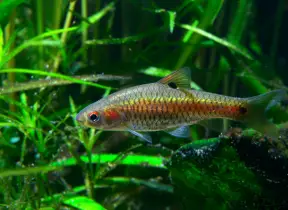
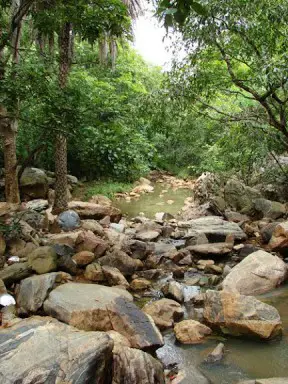
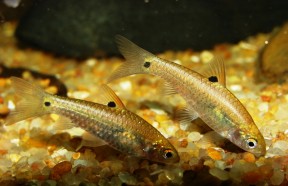
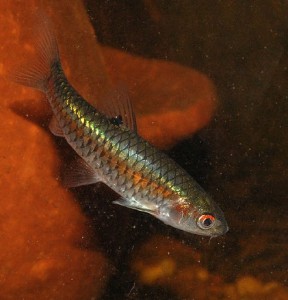
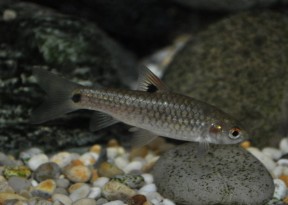
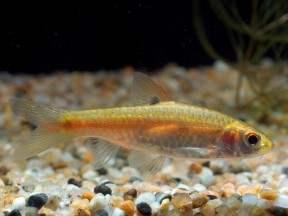

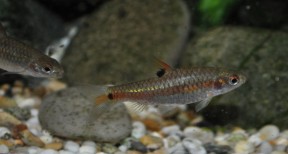


September 23rd, 2018 at 5:36 am
Photo is of a female of the species.